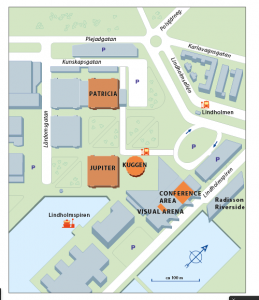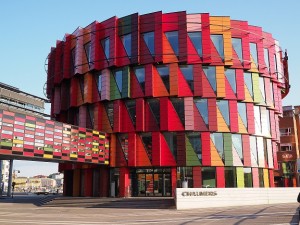NordiCHI’16 proudly presents a selection of tutorials over two days, October23-24. Tutorials offer attendees the opportunity to extend their knowledge into new areas of expertise, to explore new communities of practice and to learn about specific concepts, methods and techniques from recognized experts.
Tutorial participants must also register for at least one day at the conference.
See Full Program here!
Organizers and participants of tutorials should meet before in the pre-conference registration area in building Kuggen, Lindholmsplatsen 1. See here:
The tutorials will be held in the nearby buildings: Jupiter, Patricia and Kuggen.
Overview of Tutorials:
| Sunday Oct 23 | Monday Oct 24 | |
| 9.00-12.30 | T1 | T6 |
| lunch | ||
| 14.00-17.30 | T1, T3 | T7, T8, T9 |
——————————————————————————————————————————–
SUNDAY, OCTOBER 23
T1, Full day: Creative Worthwhile Interaction Design
Instructor: Gilbert Cockton is Professor of Design Theory at Northumbria University in North East England.
The themes of this tutorial are: practice, creativity, reflection, worth, experience, balance, integration, and generosity (worth-focused BIG design). The tutorial combines and integrates high level perspectives on design (creative, engineering, innovative worth focus, usage and contexts foci). These themes are addressed via short lectures and extensive group exercises across the day. By attending this tutorial, you will gain knowledge of
- disciplinary differences between creative, technical and human perspectives on interactive software (in particular, understand the roles of reflection in creative practices)
- strategies for applying and integrating diverse perspectives within a dynamic development process (in particular, creative and worth-focused perspectives)
By attending this tutorial, you will also become able to:
- relate research on creative and technological opportunities to research on human usage and innovation contexts
- for a given context, motivate, choose, adapt, configure, complete, combine, apply and adapt different approaches in order to systematically balance and evaluate design choices for interactive systems
- dynamically plan a balanced and integrated Lean Interaction Design process
T3, Half day (afternoon): Empirical Research Methods for Human Computer Interaction
Instructor: Scott MacKenzie‘s research is in human-computer interaction with an emphasis on human performance measurement and modeling, experimental methods and evaluation, interaction devices and techniques, alphanumeric entry, language modeling, and mobile computing.
Participants in this course will learn how to conduct empirical research in human-computer interaction (HCI). As most attendees at HCI conferences will agree, a “user study” is the hallmark of good research in human-computer interaction. But, what is a user study? By and large, a user study is an experiment conforming to the norms for empirical inquiry and the scientific method. It is founded on observation, measurement, and posing and answering testable research questions. Attendees will learn about independent variables, dependent variables, within- and between-subjects conditions, counterbalancing, internal validity, external validity, etc. The course will also include an introduction to the most common statistical tool used for hypothesis testing in HCI: the analysis of variance. No prior experience or statistical knowledge is necessary. An ANOVA tool, written by the presenter in Java, will be provided to attendees through the course’s web site (URL to follow). In short, this course delivers an A-to-Z tutorial on conducting an empirical experiment (aka user study) in human-computer interaction.
——————————————————————————————————————————–
MONDAY, OCTOBER 24
T6, Half day (morning): Visual research dissemination
Instructor: Ole Andreas Alsos has a PhD in usability from NTNU. He has long experience as an usability specialist from the industry, and has in parallel worked as a researcher and associate professor at NTNU.
Conference presentations and posters are in essence an advertisement for your research, intended to make your fellows interested in your work, to expand your network and to get your work cited. Unfortunately, most of us are neither charismatic superpresenters that captivate the audience with rhetoric, eyecontact and use of voice, nor skilled graphical designers that can dazzle their visual senses with beautiful slides or posters. We are pedagogical mediocrities that quickly risk losing the attention of our audience. However, as you will learn in this tutorial, there are simple gamechanging design techniques, based on research on the cognitive strengths and limitation of human beings, that will make it easier for the audience to understand and get interested in your research. The goal of this handson tutorial is to learn the attendees to (1) design visual presentations and posters with less text and fewer bullet points, (2) construct relevant and informative images, illustrations and figures, and (3) build readerfriendly graphs, tables and data visualizations. Several of the skills learned are also relevant for scientific papers.
T7, Half day (afternoon): Using sketching to emphasise and elaborate on HCI research
Instructors: Dr. Makayla Lewis, Royal Holloway University of London. Dr. Lewis has a passion for inductive HCIand visual methods. She completed a PhD in HCI at City University London in 2012 and is now a Post Doctoral Research Assistant on the Cyber Security Cartographies Project within the Information Security Group where she uses HCI and visual methods to draw out an understanding of how people influence the management of their data and how they use social networks to extend and maintain this influence. Miriam Sturdee, PhD candidate at Lancaster University. Miriam has an MFA from Edinburgh College of Art in Visual Communication & Illustration and has worked for publishers such as Pearson and Macmillan in book design and cover illustration, as well as a number of other clients. She also holds a Psychology MA Hons from Edinburgh University, and is currently researching the value of visual communication, storyboarding and sketching in HCI.
The tutorial is in four parts:
- Offering a background of visual thinking and sketching with examples from HCI and neighboring fields.
- Encouraging attendees to find their ‘personal style’ through a series of sketching exercises promoting confidence building and self-evaluation (intended to give participants a strong feeling as to how they will approach part three).
- Building a visual language: attendees will be asked to sketch along with the tutors (following a series of best practice examples from HCI and neighbouring fields) that will be live drawn and digitally projected for immediacy. E.g., the humble line, connectors/separators, people/actions and typography, and exercises such as a rapid sketching, interview and collaborative development of a visual icon library.
- Practice: attendees will explore and discuss how visual thinking and sketching can be integrated precisely into HCI using Mike Rohde’s “design a treehouse” and “interview your neighbour” whereby storyboards will be produced.
There will then be a short exercise on applying new found skills to sketching and speculating as to the next steps of a work or research project, e.g. visualising the next stage of a prototype and its uses, or storyboarding a user experience, this would call upon Truong et al.’s guidelines (2006).
For more information about the tutorial please go to: https://sketchinghci.wordpress.com
T8, Half day (afternoon): Virtual Reality and Eye Tracking
Note: free of charge
Instructor: William Hamilton, VR entrepreneur & researcher
Description: Eye tracking in virtual reality has enormous possibilities for both research and interaction, allowing users to develop tools for virtual environments in their own research while providing insights into a wide range of topics. This tutorial is designed to give you an introduction to virtual reality, eye tracking, and to demonstrate the potential of fusing the two technologies. The presentation will be followed by a hands-on session, where we will discuss previous use cases, demonstrate the integration solution, and answer questions on how to get started. Website with more information HERE
T9, Duration 2 hours (afternoon): Interacting and Learning in Maritime Simulators
Note: free of charge
Time: 15.00-17.00
Professional simulators have expanded from very simple representations of the real world to high fidelity simulators that mimic the reality very well. Development of game engines, computer power and decreased technological costs have made it possible to use these high fidelity simulators for professional training as a large part of the more proficiency based academic educations. The challenge lay in how to make the most of the simulators when it comes to transforming a novice into a professional. Interaction with the actual interface and physical stearing equipment is very important in that learning process.
In this tutorial the different types of maritime simulators, available at Chalmers University of Technology, will be introduced. Concepts around learning, interaction and how to capture and teach proficiency will be discussed. Ability to follow a ship through a traffic situation and to see the simulators in action will be given. Experience the bridge of a maritime vessel and learn about the captains bridge interface. See the multiple screens of information and the cockpit like maneuver board to get an understanding of the complex interaction between man and machine. Even sea sickness can be simulated. At Chalmers Campus Lindholmen we have Sweden’s most extensive simulator centre for education and research in shipping.
———————————————————————————————————————–
CANCELLED TUTORIALS::
—CANCELLED—T2, Half day (morning): Subjective and Objective Replication and Replicability
Instructors: Alan Said is an Associate Senior Lecturer at the University of Skövde, Sweden. Prior to this he was a machine learning engineer at Recorded Future. Gustaf Lindblad is a Lecturer at Chalmers University of Technology, Sweden. He teaches various topics in cognitive science at Gothenburg University as well as group dynamics for engineers at Chalmers.
The tutorial focuses on validation of data and methods from a replication and reproducibility perspective. We focus on both qualitatively collected data (user studies, surveys, video recordings) and quantitative data collected through information access systems (movie recommendation, playlist curation, etc). Our goal is to illuminate some of the similar problems with replication/reproduction related to different types of methods and data within the wide field of HCI. After the tutorial, the attendees will have an understanding of the process involved in replicating/reproducing research results, in terms of methods and algorithms, and data processing.
—CANCELLED—T4, Full day: Design and Human-Centered Computing: Quo vadis? – Envisioning andExploring Game-Changing Transformations for the Future”
Instructor: Gerhard Fischer is a Professor Adjunct and Professor Emeritus of Computer Science, a Fellow of the Institute of Cognitive Science, and the Director of the Center for Lifelong Learning and Design (L3D) at the University of Colorado at Boulder.
My research has focused throughout my whole professional career (1) to introduce long lasting research themes to HCI and (2) to integrate and mediate between HCI and a spectrum of related fields (see citation from SIGCHI Academy below). This tutorial will explore topics relevant to the theme of the NordiCHI’2016 conference “game-changing design” by exploring different, but interrelated themes shaping design and human-centered computing in the future including:
- Cultures of Participation: the rise in social computing has facilitated a shift from consumer cultures to cultures of participation.
- Meta-Design: Meta-design is “design for designers” and users are supported to become co-designers.
- Design Trade-Offs and Quality of Life (QoL): QoL is one of the most challenging design problems of the digital age. It is a wicked problem with no best solutions independent of goals, objectives, and values requiring a design-tradeoff analysis.
- Social Creativity: Individual and social creativity need to be integrated with collaboration models, shareable externalizations, and evolutionary process models.
- Context-Aware Systems: The scarce resource for many people in the world of today is not information but human attention — therefore the challenge is not to provide more information “to anyone, at anytime, and from anywhere,” but to say “the ‘right’ information, at the ‘right’ time, in the ‘right’ place, in the ‘right’ way to the ‘right’ person”.
- MOOCs and Learning in the Digital Age: In order to identify a realistic strategy for learning and education in the digital age, MOOCs and/versus residential research-based universities deserve an informed debate grounded in the learning sciences and in HCI.
As a full day tutorial lasts six hours, each of the six themes will be allocated one hour (with as much discussion as possible). This initial plan might be modified based on the interests of the participants (i.e.: more time will be allocated in case some of the themes are of more interests than others and engaged discussions evolve around them).
—CANCELLED—T5, Full day: Modern regression techniques for design researchers
Instructor: Dr. Martin Schmettow, is assistant professor in Psychology at the University of Twen-te (The Netherlands). He has more than a ten year experience in HCI research and education.
In statistics, a century of progress has passed since the introduction of ANOVA and Pearson correla-tion. But, many researchers are still squeezing their precious data into the tight corset of those dat-ed statistical models. This is particularly limiting in applied disciplines such as HCI, where impact factors can be numerous and heterogeneous and strict experimental control is not desirable or fea-sible. The proposed tutorial aims at liberating applied researchers from constraints and concerns associated with legacy statistics. After the tutorial, attendees will be able to:
- build models, with multiple categorical and metric predictors
- model and interpret interaction effects
- identify the optimal set of predictors through model selection
- analyze data from complex research designs using mixed-effects models
- use all above-mentioned techniques to create research designs that are more effective and efficient.



